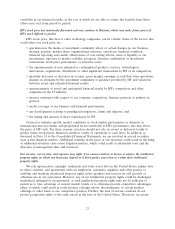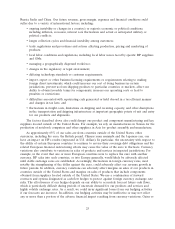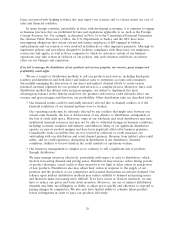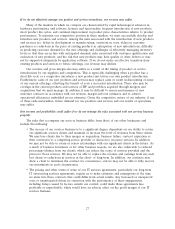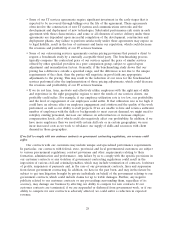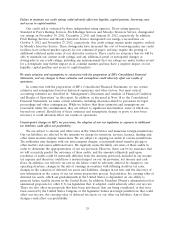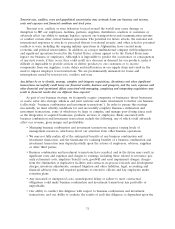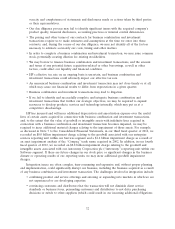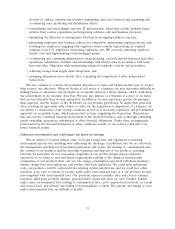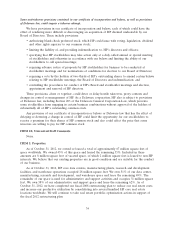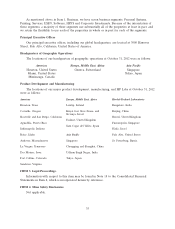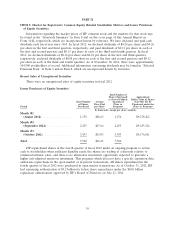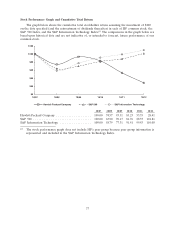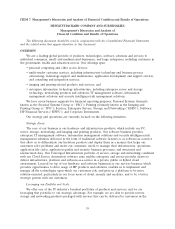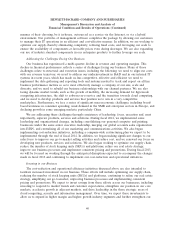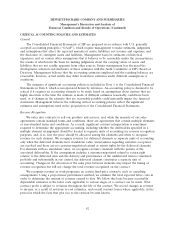HP 2012 Annual Report Download - page 41
Download and view the complete annual report
Please find page 41 of the 2012 HP annual report below. You can navigate through the pages in the report by either clicking on the pages listed below, or by using the keyword search tool below to find specific information within the annual report.in order to address customer uncertainty), minimizing sales force attrition and expanding and
coordinating sales, marketing and distribution efforts;
• consolidating and rationalizing corporate IT infrastructure, which may include multiple legacy
systems from various acquisitions and integrating software code and business processes;
• minimizing the diversion of management attention from ongoing business concerns;
• persuading employees that business cultures are compatible, maintaining employee morale and
retaining key employees, engaging with employee works councils representing an acquired
company’s non-U.S. employees, integrating employees into HP, correctly estimating employee
benefit costs and implementing restructuring programs;
• coordinating and combining administrative, manufacturing, research and development and other
operations, subsidiaries, facilities and relationships with third parties in accordance with local
laws and other obligations while maintaining adequate standards, controls and procedures;
• achieving savings from supply chain integration; and
• managing integration issues shortly after or pending the completion of other independent
transactions.
We also continue to evaluate the potential disposition of assets and businesses that may no longer
help us meet our objectives. When we decide to sell assets or a business, we may encounter difficulty in
finding buyers or alternative exit strategies on acceptable terms in a timely manner, which could delay
the achievement of our strategic objectives. We may also dispose of a business at a price or on terms
that are less desirable than we had anticipated. In addition, we may experience greater dis-synergies
than expected, and the impact of the divestiture on our revenue growth may be larger than projected.
After reaching an agreement with a buyer or seller for the acquisition or disposition of a business, we
are subject to satisfaction of pre-closing conditions as well as to necessary regulatory and governmental
approvals on acceptable terms, which may prevent us from completing the transaction. Dispositions
may also involve continued financial involvement in the divested business, such as through continuing
equity ownership, guarantees, indemnities or other financial obligations. Under these arrangements,
performance by the divested businesses or other conditions outside of our control could affect our
future financial results.
Unforeseen environmental costs could impact our future net earnings.
We are subject to various federal, state, local and foreign laws and regulations concerning
environmental protection, including laws addressing the discharge of pollutants into the air and water,
the management and disposal of hazardous substances and wastes, the cleanup of contaminated sites,
the content of our products and the recycling, treatment and disposal of our products, including
batteries. In particular, we face increasing complexity in our product design and procurement
operations as we adjust to new and future requirements relating to the chemical and materials
composition of our products, their safe use, the energy consumption associated with those products,
climate change laws and regulations, and product take-back legislation. We could incur substantial
costs, our products could be restricted from entering certain jurisdictions, and we could face other
sanctions, if we were to violate or become liable under environmental laws or if our products become
non-compliant with environmental laws. Our potential exposure includes fines and civil or criminal
sanctions, third-party property damage, personal injury claims and clean up costs. Further, liability
under some environmental laws relating to contaminated sites can be imposed retroactively, on a joint
and several basis, and without any finding of noncompliance or fault. The amount and timing of costs
under environmental laws are difficult to predict.
33


